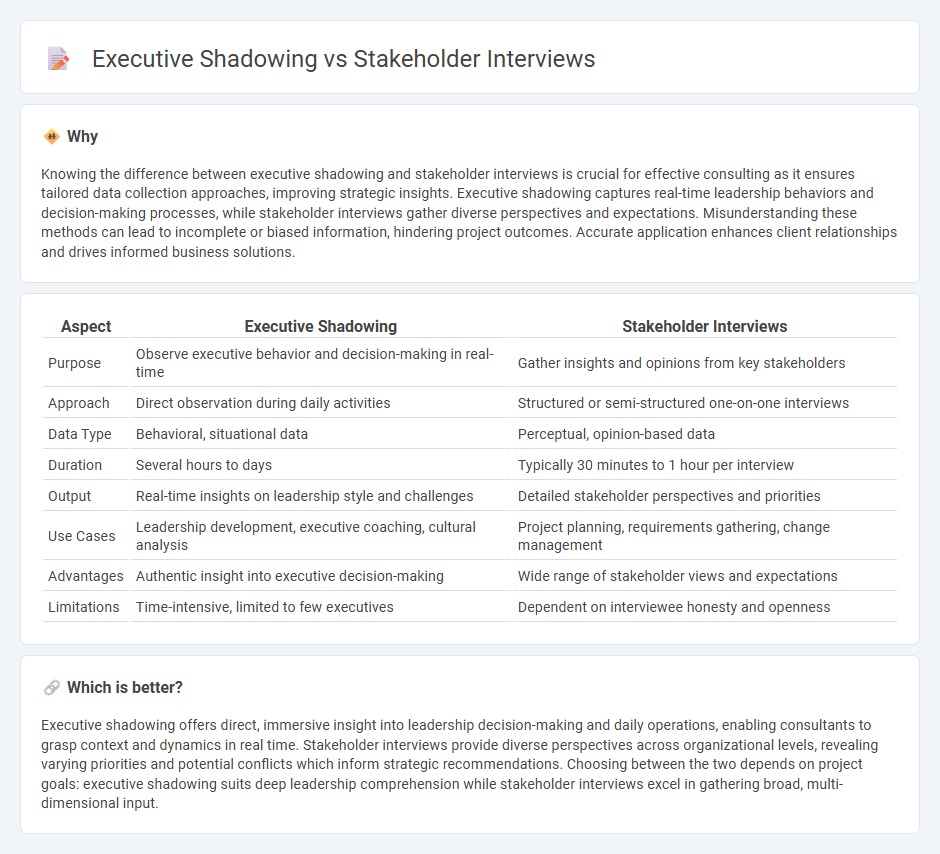
Executive shadowing offers firsthand observation of leadership behaviors and decision-making processes, providing deep insights into organizational dynamics and culture. Stakeholder interviews gather diverse perspectives directly from key individuals, uncovering priorities and concerns that shape strategic initiatives. Explore how combining these methods can enhance consulting outcomes and drive effective organizational change.
Why it is important
Knowing the difference between executive shadowing and stakeholder interviews is crucial for effective consulting as it ensures tailored data collection approaches, improving strategic insights. Executive shadowing captures real-time leadership behaviors and decision-making processes, while stakeholder interviews gather diverse perspectives and expectations. Misunderstanding these methods can lead to incomplete or biased information, hindering project outcomes. Accurate application enhances client relationships and drives informed business solutions.
Comparison Table
| Aspect | Executive Shadowing | Stakeholder Interviews |
|---|---|---|
| Purpose | Observe executive behavior and decision-making in real-time | Gather insights and opinions from key stakeholders |
| Approach | Direct observation during daily activities | Structured or semi-structured one-on-one interviews |
| Data Type | Behavioral, situational data | Perceptual, opinion-based data |
| Duration | Several hours to days | Typically 30 minutes to 1 hour per interview |
| Output | Real-time insights on leadership style and challenges | Detailed stakeholder perspectives and priorities |
| Use Cases | Leadership development, executive coaching, cultural analysis | Project planning, requirements gathering, change management |
| Advantages | Authentic insight into executive decision-making | Wide range of stakeholder views and expectations |
| Limitations | Time-intensive, limited to few executives | Dependent on interviewee honesty and openness |
Which is better?
Executive shadowing offers direct, immersive insight into leadership decision-making and daily operations, enabling consultants to grasp context and dynamics in real time. Stakeholder interviews provide diverse perspectives across organizational levels, revealing varying priorities and potential conflicts which inform strategic recommendations. Choosing between the two depends on project goals: executive shadowing suits deep leadership comprehension while stakeholder interviews excel in gathering broad, multi-dimensional input.
Connection
Executive shadowing provides in-depth observational insights into leadership decision-making, while stakeholder interviews gather diverse perspectives and expectations from key organizational members. These methods complement each other by combining real-time behavioral data with qualitative feedback, enhancing the consultant's understanding of executive impact and stakeholder priorities. Integrating both approaches ensures a comprehensive assessment for strategic alignment and organizational improvement.
Key Terms
Stakeholder Mapping
Stakeholder interviews provide direct insights into individual perspectives, priorities, and concerns, making them essential for accurate stakeholder mapping by identifying key influencers and decision-makers. Executive shadowing captures real-time interactions and organizational dynamics, revealing informal networks and power structures that static interviews might miss. Explore how integrating both methods can enhance the precision of your stakeholder mapping strategy.
Qualitative Insights
Stakeholder interviews provide direct qualitative insights by capturing diverse perspectives, motivations, and experiences across an organization, enabling a comprehensive understanding of needs and concerns. Executive shadowing offers real-time observation of leadership decision-making processes and interpersonal dynamics, revealing implicit organizational culture and behavior patterns. Explore more about how these methods deepen qualitative analysis and improve strategic outcomes.
Decision-Making Dynamics
Stakeholder interviews provide diverse perspectives on organizational goals, priorities, and challenges by engaging a broad range of participants across departments, capturing detailed insights into decision-making criteria and conflicts. Executive shadowing offers real-time observation of leadership behavior, communication styles, and spontaneous decision-making processes, revealing unspoken influences and contextual factors shaping executive judgments. Explore deeper to understand which method better uncovers the nuances of decision-making dynamics in your organization.
Source and External Links
Stakeholder Interviews - Stakeholder interviews aim to engage stakeholders by gathering information, understanding barriers and enablers, and strengthening relationships to expand perspective through their eyes.
A Handy Cheat Sheet of Stakeholder Interview Questions for UX Designers - This resource outlines how to develop open-ended questions, schedule, conduct, and analyze stakeholder interviews to capture insights that inform user experience design.
What is a stakeholder interview? A definition - Bynder - A stakeholder interview is a one-on-one conversation with individuals who have vested interests to uncover their insights, understand their needs, and identify points of friction to guide projects effectively.
 dowidth.com
dowidth.com